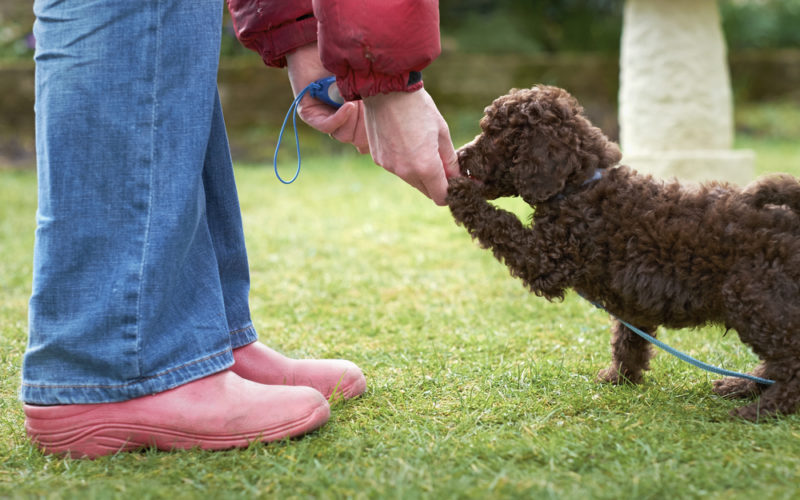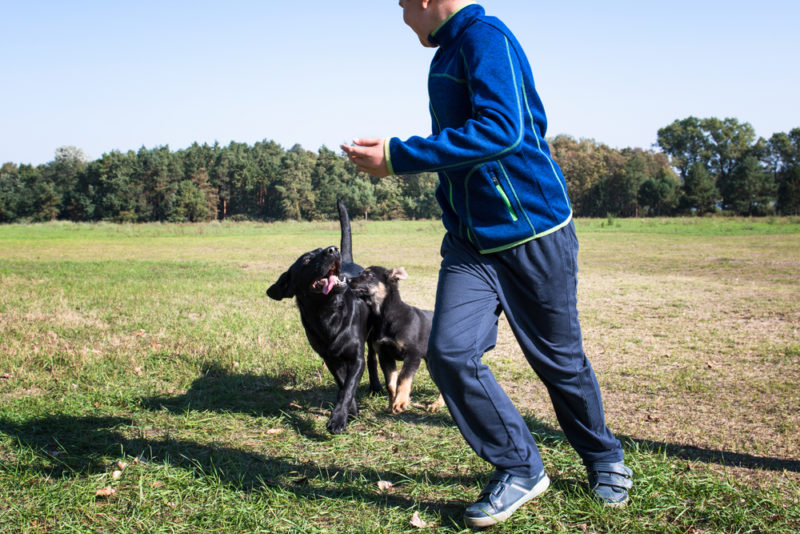Marker training can be an effective way to teach your dog new behaviors. Using a clicker can communicate to your dog that it’s done exactly what you want at the moment and tells it a treat is on the way. Knowing how to use a clicker for dog training adds a useful tool to your techniques and helps you provide clarity that isn’t always in the form of food or play rewards.
When you’re expecting something very specific from your dog, you can use the sound of a clicker at the exact moment it obeys to mark the behavior. Over time, the association between the command, click and reward helps confirm when a dog performs the precise task you expect. This can be used to ensure proper posture, to keep a dog in position until a release command is issued and to mark random behaviors that you wish to use to teach your dog fun tricks that can impress your family and friends.

What Is Clicker Training?
Clicker training (also known as marker training) uses a clicker as a marker to “mark” the desired behavior.. The sound of each click is considered a reward for your dog, so you don’t need to use a food treat or a toy each time your dog performs a desired behavior. After associating the clicks with good outcomes, dogs attempt to replicate the behaviors that result in the sound.
When going over a command with a dog the first few times, a clicker can make it much easier to teach a dog to perform the trick or maintain the position you expect. When it hears the click at the exact moment it complies, it makes it easy for the dog to understand exactly what is wanted.. In addition to teaching new commands, a clicker can help improve posture and how well a dog performs existing commands.
What Is Classical Conditioning?
Ivan Pavlov performed a series of experiments with dogs that involved the use of a bell to indicate when they were about to be fed. He noticed that if he made the dogs wait for their food, they’d begin to salivate and drool. Over time, he added the sound of a bell before showing the dogs the treats and waited for them to drool again. He was finally able to ring the bell without any treats present to get the dogs to salivate.
This is referred to as classical conditioning. It trains dogs to expect certain outcomes when a stimulus is present. In clicker training, the clicker itself becomes the bell. You’re communicating that after enough clicks, the dog will receive a treat or other form of reward. For most dogs, the click itself becomes the reward and eliminates the need to constantly give food to a dog during training sessions.
Introducing Clicker Training to Your Dog
Before you can reduce the use of food rewards in training sessions, you need to condition your dog to accept the sound of the clicker as a reward. Consistency is key, so you should always make the click at the exact moment the dog has complied with your wishes. The same rings true when you’re teaching a dog what the sound means.
To prepare for clicker training, grab a handful of treats and simply allow your dog to sniff your hand and immediately follow it wherever it goes. Once your dog knows to follow your hand, give it a treat. After it does this several times, pick up the clicker in the same hand so it knows to follow the clicker. At the exact moment you click it, give it the treat to reinforce that the click is a positive outcome.
It’s important to take some time to establish the meaning of the clicker, so don’t worry about any commands or tricks at the beginning. You’re simply making the sound of the clicker pleasant for your dog so that it comes to seek it as a reward. After a few short sessions working with the clicker and rewarding your dog each time you click, you’re able to begin removing other treats when you begin training sessions for the purpose of obedience or advanced commands.
How to Use Clickers in Your Training Sessions
When you’re first getting started, you should use treats in addition to the sound of the clicker to communicate with your dog. Instead of using a treat for it to focus on, use the hand holding the clicker. For example, you can move your hand just above the dog’s head until the dog sits. Once the dog’s butt hits the ground, you click the clicker, give praise and then give the desired treat.
Over time, give treats less frequently and use the clicker as the primary reward. It’s good to provide intermittent treats now and then, but the clicker should be the main source of communication. There’s plenty you can communicate now with the clicker, such as the exact posture you desire, to hold the position and specific markers.
Create a Marker Word for Each Desired Behavior
To make a dog learn specific commands, you need to create marker words. For example, you can use “sit” or “down” if you’re okay with traditional markers. Some trainers provide commands in a different language if they wish to prevent interference from others who’d try to command their dogs. If you notice a particular behavior that you wish to use to perform a trick, you may need to be creative when creating a marker word.
Some commands may need to be held until you wish to release your dog. Using a marker to indicate it may do as it pleases is a good way to incorporate an automatic stay into commands such as “sit,” “down” and “place.” Common release markers that trainers use include “break” and “free.”
As time goes on, you’ll be able to replace the sound of the clicker completely with the marker word for each command. After successful clicker training, you should only need to use the clicker if you’re looking to improve response times and posture or attempting to reward new behaviors you notice.
Reward Each Desired New Behavior You Notice
There are some tricks you can teach your dog that happen completely by accident. Perhaps you notice that your dog tilts its head at something and you want to train it to do that on command. Or you think it’d be funny to teach your dog to blink or wink on command. As long as you have your clicker with you, all you need to do is click and treat your dog at the exact moment the behavior is exhibited. This will make your dog repeat the behavior and you can add a marker word with the click. It may take a couple times of catching the behavior for the dog to associate it correctly, but it will happen.
Training your dog using the behaviors it displays naturally can be entertaining and helps showcase its unique personality. Others may wonder how you got your dog to learn those tricks, and it’s a fun way for it to earn praise and affection in front of other people.

Some Basic Commands to Begin With
When you clicker train your dog, it’s important to make sure that your dog understands a command before it becomes an expectation. Always reward good behavior, but don’t discipline a dog over bad behavior until you know your dog understands your expectations. Many dog owners make the mistake of not verifying that a dog actually knows how to perform a command before incorporating annoyance for noncompliance.
You can use clicker training to teach the following obedience commands:
Sit
To train your dog to sit, move the clicker above its head and wait for its butt to fully hit the floor before you make the click sound. Once you make the sound, continue to praise it as a good dog and give clicks every two to three seconds as long as it stays seated. Then give the release word and reward it with a treat. This will teach the dog it’s not expected to just sit for a moment and then do as it pleases, but to stay still until hearing the release command.
Down
The next behavior to train is “down,” and you can make your dog follow your hand down to the ground and then toward its hind legs until it lays down. Reward with a click and treat and then continue clicks as long as it stays in position. Then give the release word and praise.
Stay
To train your dog to stay, make the click sound every few seconds as long as it doesn’t move. Start with 10 seconds and then make it hold the position for longer periods during each of your sessions. Try to aim for five minutes.
Heel
The best place to begin is indoors. Hold a tasty treat in your hand and encourage your dog to follow the treat as you hold it at your side. Use the word “heel” as a marker and make the click sound as long as it remains in the area one pace ahead to one pace behind you.
Come
Begin with your dog on a long leash and when you call it, give a gentle pull. The moment it moves in the right direction and comes toward you, use the clicker until it reaches you. Reward it with praise and a food reward when it makes it all the way back to you. Eventually, you’ll be able to eliminate the use of the leash entirely.
Incorporating Hand Signals into Your Dog Training
You can use the same classical conditioning methods to incorporate hand signals into your training. Show your dog a hand signal before giving the verbal command, and reward the good behaviors the same way you would with verbal commands. Once the dog associates the hand signal with the verbal marker, it will begin to respond in the same manner.
It’s a good idea to train certain behaviors with hand signals so you can command your dog while you’re occupied in conversation or unable to speak. An example would be if you needed your dog to sit still while you signed for a package at the front door. Having it sit and stay quietly lessens your worry that it’d try to make a break for it through the open door and run free.
Practice Makes Perfect
Dogs don’t learn overnight and require regular training and reinforcement. Be prepared to spend at least a few hours every week training your dog. As you put in the time, you’re going to notice that your dog has a learning curve and improves with each session. Don’t train your dog while you’re frustrated or it’s showing signs that it’s burned out.
It’s better to have consistent shorter sessions than to train less often for lengthier periods. Try to have two 15- to 20-minute sessions each day, spaced several hours apart. Consistency is key, so understand that if you stop reinforcing a dog’s behaviors, it will begin to fall behind.
The Dog Wizard Can Help
If you’re having difficulty training your dog, The Dog Wizard can help you eliminate unwanted and bad behaviors. Your dog has a unique personality just like humans do, and dogs learn in different ways. If your dog doesn’t respond well to clicker training, there are other ways to establish a healthy relationship and effective communication.
At The Dog Wizard, our training process identifies how our clients’ dogs learn and uses the appropriate methods to ensure they understand what’s expected of them. We can identify the cause of your dog’s behavioral problems and teach you how to train it more effectively. To learn more about our training programs, give us a call at (877) 585-9727 today.













